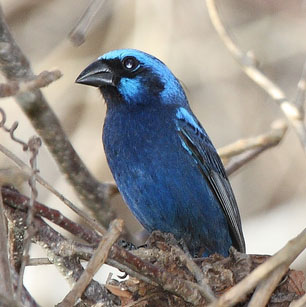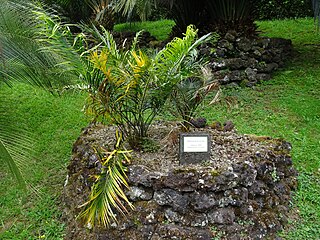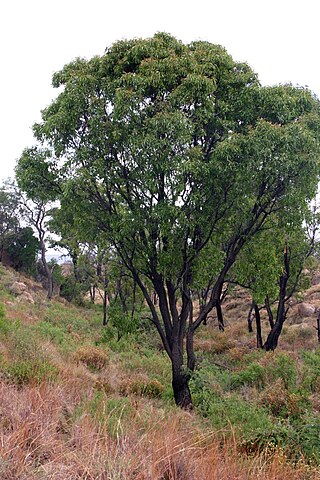
The red-chested swallow is a small non-migratory passerine bird found in West Africa, the Congo Basin and Ethiopia. It has a long, deeply forked tail and curved, pointed wings.

Gymnanthes lucida, commonly known as shiny oysterwood or crabwood, is a species of flowering plant in the spurge family, Euphorbiaceae, that is native to southern Florida in the United States, the Bahamas, the Caribbean, Mexico, and Central America.

The blue bunting is a species of passerine in the family Cardinalidae, the cardinals or cardinal grosbeaks. It is found in Belize, El Salvador, Guatemala, Honduras, Mexico, and Nicaragua.

The dapple-throat is a species of bird in the small African family Modulatricidae. Other common names include dappled mountain robin and dappled mountain greenbul. It is native to Mozambique and Tanzania. This is the only species in the monotypic genus Arcanator.

Faurea macnaughtonii is a species of tree in the family Proteaceae. It is found in South Africa and Eswatini, and was named in honour of Colin B. MacNaughton, Conservator of Forests at Knysna during the 1890s.

Faurea is a genus containing 16 species of flowering plants in the protea family which occur in the summer rainfall area of southern Africa, extending to tropical Africa and Madagascar. The name honours South African soldier and botanist William Caldwell Faure (1822-1844) who was killed on active service in India.
Klarobelia lucida is a species of plant in the Annonaceae family. It is endemic to Ecuador. Its natural habitat is subtropical or tropical dry forests. It is threatened by habitat loss.

Macrozamia lucida is a species of plant in the family Zamiaceae. It is endemic to Australia.
Meryta lucida is a species of plant in the family Araliaceae. It is endemic to the islands of Raiatea and Huahine in the Society Islands of French Polynesia.
Parashorea lucida is a species of plant in the family Dipterocarpaceae. The name lucida is derived from Latin and refers to the venation on the leaf. It is a tall emergent tree, up to 60 m tall, found in mixed dipterocarp forest on clay and clay soils. It is found in Sumatra and Borneo. It is threatened by habitat loss.

Rawsonia lucida is a species of plant in the Achariaceae family. It is found in eastern, central and southern Africa.

Faurea saligna is a graceful, semi-deciduous tree of the family Proteaceae growing to about 10 metres, or up to 20 metres under forest conditions. Found from tropical Africa south to the Transvaal, Swaziland and Natal, often in large communities on sandy soil and along stream beds.
As of July 2016, the International Union for Conservation of Nature (IUCN) lists 238 conservation dependent species. 0.29% of all evaluated species are listed as conservation dependent. The IUCN also lists seven subspecies and five varieties as conservation dependent.
Hybosida lucida is a species of spiders found on Mahe Island in the Seychelles.
Poeciliopsis lucida, the clearfin livebearer, is a species of small freshwater fish in the family Poeciliidae. Reproduction is viviparous, and the female can have several clutches of young developing internally at the same time. It is one of several species of small livebearing fish endemic to Mexico that were described in 1960 by the American ichthyologist Robert Rush Miller.

Faurea galpinii is a small tree that grows to 10 m tall, but its trunks will vary depending on growing conditions. The leaves of F. galpinii are alternately lanceolate with wavy margins. When growing in the forest, the bark appears grey with smooth, concentric rings, although it can appear rough and dark under exposed conditions, and the variety Faurea gal pinii varies in size from 1 m to 2 m.

Faurea rochetiana, also known as the broad-leaved beechwood, is a tree found in much of Africa from Sudan south to Limpopo, Mpumalanga and northern KwaZulu-Natal. The tree is small and leafy. It has wider leaves, larger flowers and flower veins and also denser hairy twigs than the bushveld beechwood. The tree's national number is 76.
Faurea recondita, also known as the Kamdeboo beechwood, is a tree that forms part of the genus Faurea. It occurs in the Kamdeboo Mountains. The species was only identified in 2013 after it was discovered in 2008. The tree grows on average two metres high. It has many similarities with Faurea coriacea found in Madagascar.
Faurea forficuliflora is a tree that forms part of the Faurea genus and is endemic to Madagascar.
Faurea coriacea is a tree that forms part of Faurea genus.











